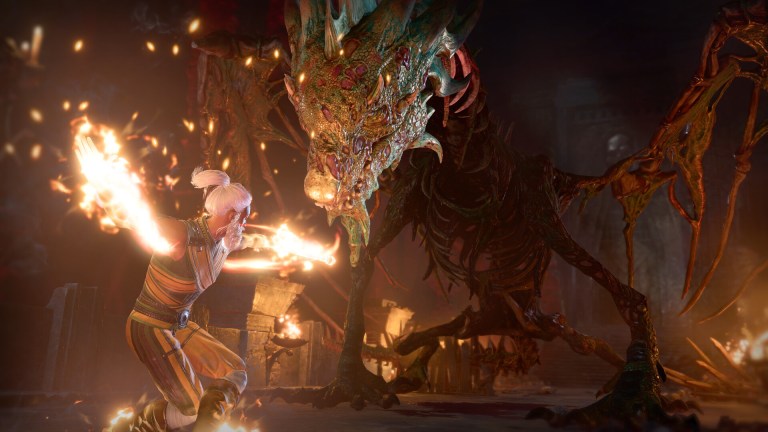Baldur’s Gate 3: Best Party Compositions and Team Strategies
Can't decide on the perfect party in Baldur's Gate 3? Here are a few team comps that will help you survive any encounter.

Assembling the right party is an important part of the Baldur’s Gate 3 experience. Indeed, the moment you realize you can only roll out with three companions at any given time is the moment you’ll realize how valuable the right team can be.
However, like so many other aspects of Baldur’s Gate 3, assembling the optimal party is as much about your preferences and the situation before you as it is about the game’s raw mechanics. You can make just about any combination of classes work in this game, though most of the best combinations will follow the basic “Tank, Healer, Melee DPS, Ranged DPS” setup.
Of course, since Baldur’s Gate 3 plays with traditional role-playing…err…roles in rather interesting ways, you don’t necessarily have to follow that tried and true formula to make it through the game. To give you a better idea of what is possible, here are some of the best party combinations I’ve found in Baldur’s Gate 3 so far.
The Classic
Fighter/Barbarian, Rogue, Wizard, Cleric
Pretty much your bread-and-butter party comp, this classic combo offers a lot of benefits and few notable weaknesses.
The Fighter or Barbarian fills the “tank” role in this party (such as it exists in Baldur’s Gate 3). They’re there to deal impressive damage at close ranges and eat as many hits as reasonably possible. Clerics are basically Swiss Army support tools, which is nice for those times when you want to be able to reasonably keep up with what the game may throw at you.
Clerics are also fairly durable, which means they offer just enough of a distraction to allow the Rogue to gain those valuable Advantage attacks. Wizards are also a natural pick for their combat versatility, though you may end up treating them as your go-to AoE option. If that is the case, then a properly build Sorcerer may be an even more valuable combat companion.
Again, this is a safe, combat-focused party that should be able to get you through pretty much anything.
Pure Damage
Ranger, Rogue, Paladin, Sorcerer
If you’re feeling brave and want to try to push a ton of damage, consider giving this party comp a shot.
In this party, the Paladin serves as both the tank and a heal/support character. While it can be very risky to have one character try to serve both of those roles, the Paladin is uniquely capable of doing just that when properly managed.
Besides, a properly positioned Paladin allows you to fill the rest of your party with pure damage. Rangers and Rogues actually make for a fairly deadly combo due to the synergies between the Ranger’s “target mark” abilities and the Rogue’s general target isolation tactics. They can absolutely bully a single target, which is nice for those times when you need to get a specific enemy out of the way early
I would recommend putting a Sorcerer in that last spot due to their incredible AoE attacks and how those AoE abilities allow the Ranger and Rogue to do their things. Wizards are also quite nice in that position for many of the same reasons, and some of their utility abilities can help you make up for the heavy burden the Paladin currently has to bear.
The Role Players
Bard, Wizard, Druid, Fighter
This merry band of misfits is not only thematically fascinating but works together surprisingly well due to their shared ability to play many parts in combat.
The key to this party is the Bard. One of the best support classes in the game, the Bard is able to offer various kinds of buffs, debuffs, and heals depending on how you build them. Their versatility allows you to be both proactive and reactive, which is also true of the shapeshifting Druid. Those two classes offer you a ton of options in a lot of different situations. That can be a bad thing for those times when you want to focus on a particular strategy, though it is nice to always have options if you’re confident you can make the most out of them.
Wizards are mostly here for their AoE, though their wider range of spells does allow them to contribute to the “be ready for anything” approach this party is built for. While I would usually go for Barbarians in the frontline of a slightly squishier party, Fighters are more capable of adjusting to emerging combat situations, which is what you’re looking for in this party.
Melee Masters
Paladin, Cleric, Rogue, Monk
Though this isn’t the most efficient party comp out there, it is an interesting option for those looking to maximize their melee damage potential.
Paladins are essentially the tanks in this set-up, though they can throw out valuable support spells when asked to do so. Similarly, the Cleric is your go-to healer, but they’re just tanky enough to stay in the fight when called upon to do so.
Ultimately, both of those classes are there to support the Monk. Though I think that Monks are a bit weak at the moment, they can unleash some devastating melee might when you properly compensate for their lack of natural defenses. Well, that’s what the Paladin and Cleric are here to do. Use those classes to support the Monk’s melee assaults, and you’ll be able to get the most out of that high DPS class.
I’m going with a Rogue for the final spot since they tend to make the most out of the distractions that melee classes provide. You can also roll out with a Fighter if you really want to get in everyone’s face, though the Rogue typically finds themselves in a good position to finish off those enemies that survive the strong initial blows our other characters will be dishing out.
The Adventurers
Bard, Rogue, Druid, Barbarian
While most of the team comps on this list are combat-focused, this particular party excels at the role-playing aspects of the game.
Basically, this party is designed to ensure you have access to the maximum number of theoretical interaction options at any given time. The Bard is your charisma machine who also brings some incredible unique class interaction options to the table (though a Warlock could occupy this same space). Druids are the best at interacting with various forms of wildlife (and accessing unique nature-based dialog options), while Rogues will ensure you never miss out on stealth-based opportunities and other, typically less savory, dialog options.
Barbarians, meanwhile, enable you to brute force your way through numerous obstacles (including dialog decisions). For those times when you just need to smash or intimidate something, they’re often your best bet.
Oops, All Minions
Warlock, Ranger, Druid, Cleric
While I can not in good conscience vouch for the min/max viability of this group, I will say that they are a lot of fun.
Every class in this party has the ability to summon some kind of minion or “helper” during combat. While some classes are more capable in that role than others (Warlocks are clearly the best minion summoners in the game), the basic idea is to pollute the most difficult battlefields with your best minions and overwhelm your enemies. Again, it’s strategically shaky and undeniably entertaining.
Clerics are a flex option here. I find that their ability to summon holy weapons is reason enough to run them in the support spot, but if you’re looking to lean into the theme a bit more, you always have other options.
Magic Missiles
Druid, Bard, Wizard, Sorcerer
A party comprised largely of magic users in Baldur’s Gate 3 is a pretty big ask. The nature of the game’s combat system means that you will have to occasionally rely on a more physical class from time to time. However, I think this particular comp comes close to fulfilling that fantasy.
The Druid is certainly the tank of this build, though even Druid tanks rely on magical abilities more than most close-range class options in the game. I think a Paladin also works well in this spot spending on how you build them (though Druids feel a bit more thematically appropriate).
The Bard, meanwhile, is an ideal mystical support class. Their wide array of creative support spells lets you properly prepare a party for nearly any situation. Indeed, a lot of their best abilities specifically support casters, which is obviously quite nice in this particular comp.
Wizards and Sorcerers are DPS monsters in this build. I would recommend letting the Wizard do the AoE work while the Sorcerer focuses on single-target damage, but you can play around with those specific roles depending on your builds and needs.
The Boss Killers
Barbarian, Warlock, Ranger, Cleric
Do you know you’re coming up on a boss fight and just want to maximize your single-target damage? This comp might be right for you.
Barbarian is probably the best single-target melee class in the game. They offer a potent combination of raw single-target damage and natural defenses. You could slot a Paladin or a Fighter into that spot (each offer much more versatility), though the Barbarian is best at simply holding the line.
Clerics are the safest overall support option, though a Bard offers an interesting alternative for those times when you’re just trying to push as much damage as possible with your other party members. If you decide to go with a Paladin in that Barbarian slot, then definitely consider a Bard. Otherwise, Cleric is the way to go.
Warlocks and Rangers are not usually your best overall DPS options, but they’re quite valuable against single targets. Both can push high single-target damage, both bring a ton of debuffs to the table, and both can use their minions to distract, annoy, and damage a boss. If you can keep them alive, they can do a lot of work in these spots (though Rogues are also quite good in one of those roles).
